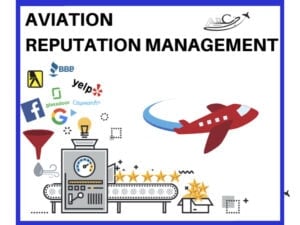We talked in the last few weeks about how important online reviews can be, and how even the best companies sometimes get negative reviews through no fault of their own.
We also talked about “the best defense is a good offense,” and how having a number of positive reviews can insulate you against the effects of a few bad ones.
Which begs the question:
How do you get more positive reviews for aviation companies?
1) Ask busy aviation customers when they’re thinking about it, (and happy!) and
2) Make it SUPER easy.
As a bonus,. intercept bad reviews before they become a part of your “permanent record” online!
[embedyt] https://www.youtube.com/watch?v=ZU5Tm-wRx9o[/embedyt]
[smart_track_player url=”http://traffic.libsyn.com/aviationmarketing/How_to_Get_More_Reviews_-_Podcast.mp3″ background=”default” ]
Transcript – How to Get More Positive Reviews
Paula W.: Welcome to this week’s episode. I’m Paula Williams.
John W.: I’m John Williams.
Paula W.: And we are ABCI and ABCI’s mission is …
John W.: To help all your ladies and gentlemen out there in the aviation world, sell more products and services.
Paula W.: Absolutely.
John W.: And, manage your reputation.
Paula W.: Right? Which helps you sell more products and services.
John W.: Exactly.
Paula W.: So anyway, we are doing a three-part series on aviation reputation management, aka Defense Against the Dark Arts, right?
The Third of Three Episodes
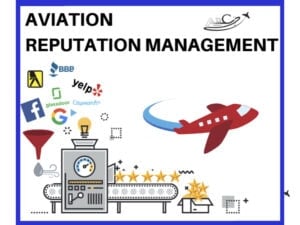 John W.: This is version three.
John W.: This is version three.
Paula W.: This is episode three. So third in the series. And all three of these episodes have been brought to you conveniently by our Aviation Reputation Management product, which is a product/service, it’s software plus service that we’ve put together to help aviation companies specifically manage their reviews. And this is getting a lot more important over the last couple of years because these reviews are getting more influential and also people are becoming more aware of how influential they are. And I think they’re using them in some cases to really beat up companies. And also, a lot of companies who don’t deserve it are being hurt by bad reviews. So we want to make sure that we can prevent that if we can, either by telling you how to fix it or by helping you fix that if you engage us to do that.
John W.: Right.
Paula W.: All right, so Defense Against the Dark Arts.
John W.: Picture always makes me smile.
 Paula W.: Exactly. This is Professor McGonagall from Hogwarts, the school of witches and wizards in the popular Harry Potter series. If you have kids, you know exactly what I’m talking about. If you don’t have kids, then borrow some, because this is definitely worth going to a movie and finding out about. But anyway, one of the things that the teachers at Hogwarts talk about is should we teach these young witches and wizards how to defend themselves against the Dark Arts? Or should we just assume that they’ll never encounter any evil anywhere in the world.
Paula W.: Exactly. This is Professor McGonagall from Hogwarts, the school of witches and wizards in the popular Harry Potter series. If you have kids, you know exactly what I’m talking about. If you don’t have kids, then borrow some, because this is definitely worth going to a movie and finding out about. But anyway, one of the things that the teachers at Hogwarts talk about is should we teach these young witches and wizards how to defend themselves against the Dark Arts? Or should we just assume that they’ll never encounter any evil anywhere in the world.
John W.: And let them figure it out themselves.
Paula W.: Right.
John W.: If they survive.
Paula W.: Exactly. And I think that’s the way that a lot of companies consider these review sites and other kinds of things. It’s just, should I be proactively managing my reviews or should I just ignore that and let whatever’s going to happen, happen. And our contention is you really should be managing that.
Monitoring the Review Sites = Listening to Customers
John W.: To do that you have to be on various social media, at least monitoring them.
Paula W.: Exactly. And if you don’t know what people are saying, then you really can’t do anything about it. So last week we talked about the five reasons for bad reviews and how to go about fixing them. So if you’ve listened to that episode, that’s fantastic. If you haven’t, you might want to go back and and do that before we talk now. Because if you are not prepared for bad reviews, then you might be afraid of getting more reviews. Because chances are if you’re asking for reviews, some of them are not going to be 100% positive. Right?
John W.: Oh, you wouldn’t say that.
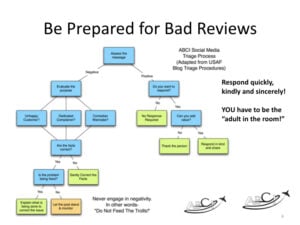 Paula W.: No, I wouldn’t say that, but I am. So seriously, if you can remove that fear so that you know how to handle a bad review when you get one, then you’re going to be a lot more prepared to do the things that we’re going to talk about in this episode, which is kind of the advanced Defense Against the Dark Arts. Right?
Paula W.: No, I wouldn’t say that, but I am. So seriously, if you can remove that fear so that you know how to handle a bad review when you get one, then you’re going to be a lot more prepared to do the things that we’re going to talk about in this episode, which is kind of the advanced Defense Against the Dark Arts. Right?
John W.: Exactly.
Paula W.: Okay. So you know what to do, for example, about a jealous competitor. You know about the terms of service of some of these review sites and you know how to file a complaint saying that someone has done something-
John W.: Inappropriately given you a bad review.
Paula W.: … Yeah. Inappropriate. So you know how to deal with that. You know how to respond to a bad review if it is appropriate and all of those things. And you’re actually in a position to feel good about communicating with customers, real customers. And the ones that are not real, you know what to do about them.
Reviews You Ask for Are More Likely To Be Positive than Unsolicited Reviews.
Okay. That all being said, reviews that you ask for are a lot more likely to be positive than unsolicited reviews. So no matter how happy you are with a company, you are a lot less likely to leave them an unsolicited review than if they actually ask for it. And there’s a couple of reasons for that. It’s a pain in the neck to go figure out where they are on Yelp or Facebook or Google My Business or wherever it is at that you want to review them and it’s hard to find the exact link and it’s hard to go there and it’s hard to figure out exactly what you want to say. And you’re busy and you’ve got a million other things to do. So-
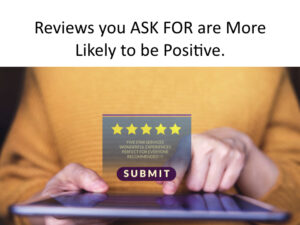 John W.: On top of that, some companies, every time you interact with them, say, “Here, review us please.” And that’s not good either.
John W.: On top of that, some companies, every time you interact with them, say, “Here, review us please.” And that’s not good either.
Paula W.: … Right. You want to make that selective. So, this is my pest control story, which has actually relevance to aviation. We’ll come back to that in just a minute. But, so, we have a company that manages the pests in our house, yard, whatever and so forth and so on.
John W.: Hopefully manages means delete. Removes.
Paula W.: Right. Exactly.
John W.: Prevents.
A Pest Control Example – Asking For Reviews
Paula W.: And, you don’t think about your pest control company until there is something waving its antenna at you. Right? So positive is not necessarily, it doesn’t attract attention and negative attracts attention. Right? Especially for a pest control company. So I thought this company was really smart the way they handled this. We called because we were seeing a lot of wasps in our backyard and we couldn’t find the nest. We didn’t know where it was. So the guy came out and he was really nice, very friendly and helpful and he actually sat on our back porch and ate his lunch and watched the wasps to try and figure out where they were going. And he found some nests and he sprayed them. So, he went above and beyond the call of duty.
 And then when he was leaving he handed me this card, this little postcard-size thing. And he was going on about what he did and how he did it and everything. And I was trying to get rid of him because I was late for a meeting and everything and stuff. And he’s telling me all the details about these wasps and I really don’t care. I just want them gone. Right? And he hands me this card and I didn’t even look at it. I just put it on the table. Right? But he was very specific about handing me this card and really wanting me to be aware of what he did and how he did it.
And then when he was leaving he handed me this card, this little postcard-size thing. And he was going on about what he did and how he did it and everything. And I was trying to get rid of him because I was late for a meeting and everything and stuff. And he’s telling me all the details about these wasps and I really don’t care. I just want them gone. Right? And he hands me this card and I didn’t even look at it. I just put it on the table. Right? But he was very specific about handing me this card and really wanting me to be aware of what he did and how he did it.
So later, cleaning up the table, I found this card and it said if you liked our service, leave us a review on one of their review sites. And they said they had a couple of them listed. And I think Angie’s List and Yelp and some of these others. Leave us a positive review on any one of these sites and the person who did your service will get a $10 tip. Okay. So that was clever. It gets around, most of the sites have an injunction, you know, you cannot pay for reviews. So, they can’t give me $10 but they can give $10 to this guy who came out and sat on our porch eating lunch.
John W.: So everybody wins.
Paula W.: So everybody wins.
John W.: If it’s a good review.
Paula W.: Yeah, if it’s a good review. If it’s a bad review then-
John W.: They take $10 from him?
A Second Opportunity to Make it Right Benefits Everyone.
Paula W.: … No, I don’t think so. But, they have a problem that they can solve and a problem that you know about is one that you can solve. So I don’t think there’s any such thing as a bad review. How you handle it is going to influence future customers. Even if it is something that’s a bad review. Everybody screws up every now and then. So anyway, I thought this pest control company did a really fantastic job. But it proves the point that I was so resistant, even though I liked what this guy did, I didn’t review him then. I didn’t look at this card he handed to me. I put it on the table until a week later, chances are it could have been thrown out and I never would have given him a good review, even though I was satisfied.
That said, if we found a tarantula in the backyard tomorrow, I’d be all over those sites saying, “There’s a tarantula in our backyard, and we have these guys for pest control.” So people are spring-loaded to the negative, especially for things that-
John W.: Yeah, but on the other hand, a single phone call and they’re out there in a day or two.
Paula W.: … Oh yeah. And that’s really what I would do is I would call them and say come fix this situation. But if I were inclined to leave reviews, that would be something that’s a lot more likely over something negative than something positive. Right? So I try to give them positive reviews and I try to be a positive person, but not everybody is. Right? And even though I’m a positive person, I still am not inclined to leave a positive review unless I’m really provoked, right?
John W.: True.
Paula W.: You too.
John W.: Yeah. Oh yeah. If I leave a positive review, they have really done something out of the ordinary.
Paula W.: Right, exactly.
John W.: I just don’t do that. Sort of like telling your kid, great job for reading. I ain’t got to do that. They’re doing their job and they don’t go above and beyond, then why should I review them?
Paula W.: Right. Unless they’ve had pneumonia for a week, then you tell them, great job for breathing. But anyway, there’s always a circumstance. But the point is, unsolicited reviews are a whole lot more likely to be negative than positive. So your best defense is to solicit reviews. Right?
John W.: One of your best defenses.
How to Ask for Reviews – On Autopilot
Paula W.: Right. There’s lots of ways to solicit reviews. This is the software that we use. It’s got widgets that you could put in your website and you can see what those look like. You can make them look different. You can change the way they look, whether they have stars or whether they’re big or small or whatever. You can put those in your signature line on your email.
John W.: Or your IT person can.
Paula W.: Exactly. Or we can, if you hire us to do it for you!
John W.: Or we can, yeah, that’s right.
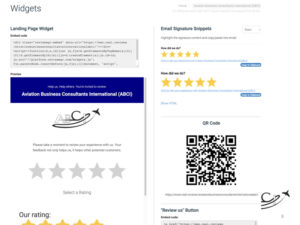 Paula W.: They give you a little QR code that you could use on your printed materials if you want people to leave you a review. There’s lots of ways to make this work and you want to make it as easy as possible. This card that I got from my pest control company, and I unfortunately have since thrown it out, but it had a QR code on it. So, that was kind of clever, especially if you’re using printed materials. Or you can use an easy URL that they can get to because not everybody knows how to do this yet.
Paula W.: They give you a little QR code that you could use on your printed materials if you want people to leave you a review. There’s lots of ways to make this work and you want to make it as easy as possible. This card that I got from my pest control company, and I unfortunately have since thrown it out, but it had a QR code on it. So, that was kind of clever, especially if you’re using printed materials. Or you can use an easy URL that they can get to because not everybody knows how to do this yet.
Okay, so soliciting reviews. Since we started doing this, we have gotten a lot of reviews from people that we know. And we actually were very specific, we asked people if you like our podcast, if you like our articles? If we’ve done a consultation with you, you don’t necessarily have to be a customer. We would like you to let us know how we’re doing, and how we’re working with you.
John W.: We use that to improve our service.
Paula W.: Exactly. And we want to improve our podcast. We want to improve our articles and that expands the number of people that we’re asking for reviews beyond customers who were actually paying us money. Right?
John W.: I can’t do a lot about you talking all the time though.
Paula W.: Do you want to?
John W.: No. Women had 50,000 words a day to get out and men only have 25.
Paula W.: There you go.
John W.: Rule of thumb.
Paula W.: So that would be a superfluous review if we got one like that, that Paula does all the talking. Yeah.
John W.: She’s supposed to.
 Paula W.: What do you think is going to happen? Right? Okay. So, but if you look at the dates on these, I wanted to point this out, since we started using this software we got a whole bunch on the same day and I’ll tell you how we did it. The software has this feature, and we’re going to do this for everyone that starts with us with this software, where they send an email out. And if you are on our list, if you open emails from us on a regular basis, you will have gotten an email from us asking you for a review. And if you click that, then you have the opportunity to leave it on Facebook or Google or I think those are the only two that we are selectively encouraging right now.
Paula W.: What do you think is going to happen? Right? Okay. So, but if you look at the dates on these, I wanted to point this out, since we started using this software we got a whole bunch on the same day and I’ll tell you how we did it. The software has this feature, and we’re going to do this for everyone that starts with us with this software, where they send an email out. And if you are on our list, if you open emails from us on a regular basis, you will have gotten an email from us asking you for a review. And if you click that, then you have the opportunity to leave it on Facebook or Google or I think those are the only two that we are selectively encouraging right now.
Other people have other sites that are more important to them and that’s fine too. So we can set that up however you want. Those are the two that we’re focusing on. In your situation, it might be different. But, we got a lot of them on the same day. Prior to that, we had not gotten a review for over a year on Google. Right? And the reason is because we’ve never encouraged reviews. And, that’s not something we’ve ever asked for. We’ve asked for reviews on LinkedIn and we occasionally do a survey and then we ask people what did you think and things like that. But we don’t ask people to go to Google and leave a review. And you specifically have to, otherwise it doesn’t work. Right?
John W.: True.
Paula W.: Okay.
John W.: The software’s quite helpful on that.
Paula W.: Right. Another thing that this lets you do is it lets you choose which reviews to display. Now, some people are going to say this is dishonest or selective, right?
John W.: Of course it’s selective.
 Paula W.: Of course it’s selective. Exactly. So, you may want to choose reviews that are particularly relevant to a person that you’re working with. So let’s say you are working with a prospect that wants a new website, you’re going to send him the reviews about websites you build. If someone wants to do a charter flight, you’re going to send them reviews about charter flights, not about your MRO service.
Paula W.: Of course it’s selective. Exactly. So, you may want to choose reviews that are particularly relevant to a person that you’re working with. So let’s say you are working with a prospect that wants a new website, you’re going to send him the reviews about websites you build. If someone wants to do a charter flight, you’re going to send them reviews about charter flights, not about your MRO service.
John W.: Exactly.
Paula W.: Also, you’re going to want to display your best items. That’s what advertising is, is showing your best side to people who want to do business with you. Okay, so this software has a neat feature that I really like and that is allowing you to intercept bad ratings proactively. Right? And you can do this without software. You can do this just by your business process. If you are asking for reviews or if you’re asking how did we do after every interaction, then you’re a lot more likely to get honest response, right when you have the opportunity to do something about it, not after it’s escalated. And I think that’s just a good business practice, not just good advertising. Right?
John W.: Right.
 Paula W.: Okay. So on all of our articles, we have a link on our articles, “Please help us out by leaving a review.” And that will take you a form that looks like this. Take a moment to review your experience with us. Your feedback not only helps us, it helps other potential customers. Now, the magic here is that if you give us a three-star review or fewer, that comes directly to me, right? Rather than going to the review sites. So it sends me an email saying this person has a problem, and then it’d ask them for the details of the problem.
Paula W.: Okay. So on all of our articles, we have a link on our articles, “Please help us out by leaving a review.” And that will take you a form that looks like this. Take a moment to review your experience with us. Your feedback not only helps us, it helps other potential customers. Now, the magic here is that if you give us a three-star review or fewer, that comes directly to me, right? Rather than going to the review sites. So it sends me an email saying this person has a problem, and then it’d ask them for the details of the problem.
I get to resolve that by email with them. It doesn’t prevent them from going off and leaving a review, but it’s not going to help them either. By giving them, if they give them four stars or more then we are going to help them, and we’re going to give them the links to Facebook and Google, which are the two review sites that we care the most about. So then they can click on that Facebook site and it will open a form and they can leave us a review on Facebook. Or if they want to leave a review on Google, they click the Google, it opens a form, they fill that out. End of story, makes it super-easy for them
John W.: And if you get a three-star or fewer and you get this email, then you absolutely better respond to it.
Paula W.: Absolutely. So, this is why this is honest. This is why this is a good business practice and not just superfluous advertising. You have to respond.
John W.: If you don’t, you’re going down.
Paula W.: Right, exactly.
John W.: They’ll realize it.
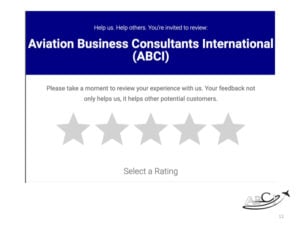 Paula W.: This assumes good intentions on your part. And also even if they would give us a four star review or better, it’s still going to ask them if there’s something that you’d like to resolve privately with us and if so click here. And it will give them a chance to send me an email. And those emails I have tagged so that I respond to those first when they come in. So, obviously if somebody’s got an issue, that’s something that needs to be handled.
Paula W.: This assumes good intentions on your part. And also even if they would give us a four star review or better, it’s still going to ask them if there’s something that you’d like to resolve privately with us and if so click here. And it will give them a chance to send me an email. And those emails I have tagged so that I respond to those first when they come in. So, obviously if somebody’s got an issue, that’s something that needs to be handled.
So that’s how the software works. You can do that without software just by programming your website in certain ways. And also in making sure that you ask people after every interaction and make sure you’re proactive about how you-
John W.: Software and our service just makes it a no-brainer.
Paula W.: Right. And we all only have so many hours in the day and it’s so easy to miss a review on one of the sites that you didn’t even know about, that you or your customers might be seeing and making a decision not to even talk to you because they seen something bad somewhere. And you don’t even know it exists. So, that’s one of my biggest fears for our customers. And so that’s how we’re using software to resolve that.
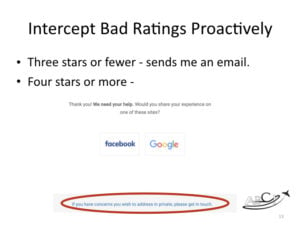 Okay, so this is again the third of the three-part series. You might want to go back two weeks and listen to Why Managing Reviews is Important. It has some case studies and things like that of how companies either succeed or fail, often based on reviews. The second one is Five Types of Bad Reviews and How to Respond to Them. And then this one is How to Improve Your Odds.
Okay, so this is again the third of the three-part series. You might want to go back two weeks and listen to Why Managing Reviews is Important. It has some case studies and things like that of how companies either succeed or fail, often based on reviews. The second one is Five Types of Bad Reviews and How to Respond to Them. And then this one is How to Improve Your Odds.
So, hopefully that will be helpful to you. You can also download our Reputation Management worksheet, which has our triage process, reasons to escalate and suggested responses for common problems. So it has some verbiage that sometimes will help you get over that hump and and respond kindly and quickly in all those things that we talked about.
So, this episode has been brought to you by our Aviation Reputation Management product/service, which is our response using software and service to help our customers manage their reviews better. So thank you for joining us and we’ll see you next week.
John W.: Have a great day. See you next time.

